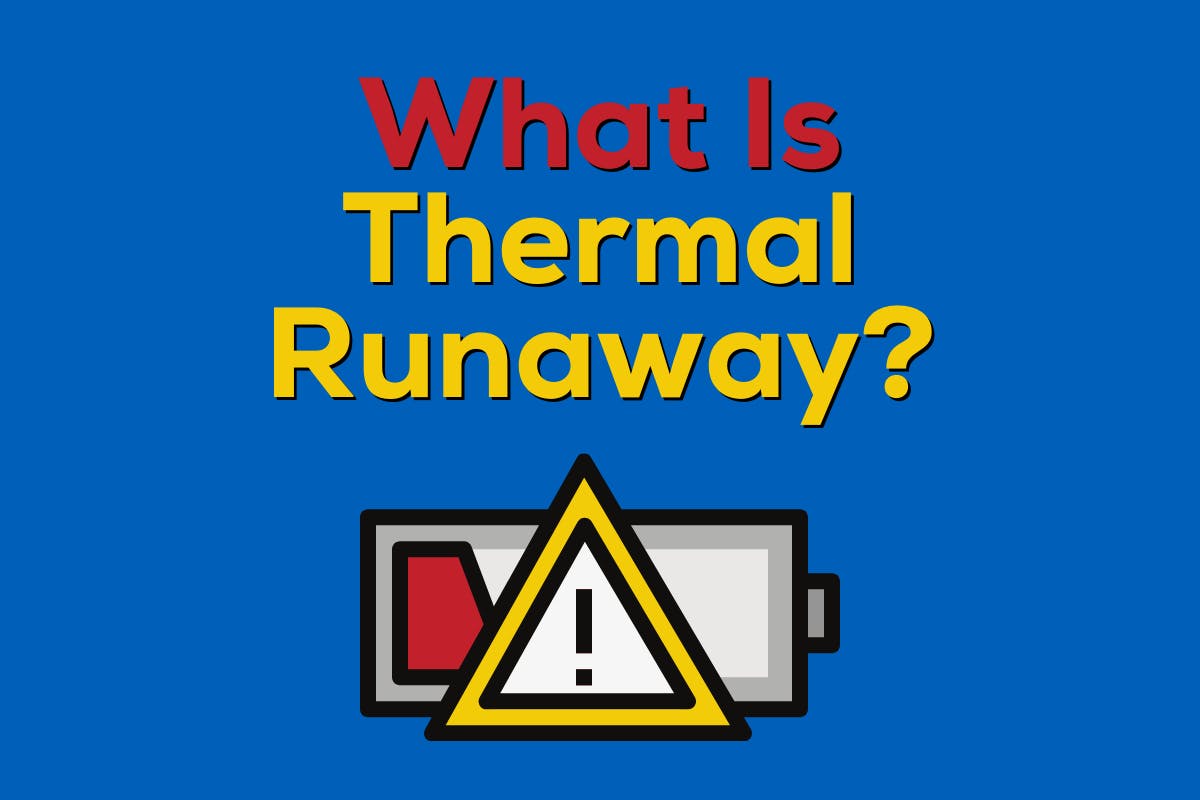What Is Thermal Runaway? Is It a Risk for Solar Batteries?
Last edited

Author
Andrew Blok
Electrification and Solar Writer and Editor

Editor
Ryan Barnett
SVP, Policy & New Market Development

Solar batteries are increasingly common in home solar installations. They’re safe, clean, quiet, and hard at work boosting savings from solar panels and providing backup power during outages.
Still, when home (and electric vehicle) batteries were less familiar, you’d occasionally see news stories about the risk of them catching fire from something called thermal runaway.
It’s important to acknowledge that thermal runaway is a real phenomenon. It’s also important to recognize the overall risk is very low, especially when the battery is installed well and isn’t damaged after the fact.
We’ll address the topic with extra care and caution and discuss the primary causes of thermal runaway, how it occurs, and what you can do to prevent it.
See how much you can save by going solar with Palmetto
What Is Thermal Runaway?
Thermal runaway is a phenomenon that may occur in energy storage systems using lithium-ion technologies, including solar battery backup. This phenomenon is more commonly associated with larger storage capacity installations, such as commercial-scale or utility-scale applications.
Thermal runaway happens when the rate a battery generates internal heat is higher than the rate the heat is released. If this overheating scenario is not remedied in a timely manner, the internal battery temperature will continue to rise, which can damage the solar battery and possibly cause a fire.
Lithium batteries use a battery management system (BMS) to make sure they always operate within specific voltage, temperature, and charge states when charging and in use. In addition, these parameters must be adjusted as the battery cells age, since the battery requirements can change over time.
Thermal runaways can be scary and expensive. Catching the early warning signs can help you avoid costly home battery replacements, and ensure your solar panel batteries continue to work properly.
What Causes Thermal Runaway?
Three main forms of battery abuse can cause a thermal runaway: thermal, electrical, and mechanical.
Thermal abuse
Batteries are designed to work within a range of ambient temperatures. Keeping your battery within that set range helps protect its internal workings and temperature regulation. Check the manufacturer’s recommendations.
(Note: Ambient temperature refers to the temperature surrounding the battery, not the temperature inside the battery bank casing.)
If ambient temperature consistently remains high, it limits the ability of the battery to expel heat to its surroundings. When that happens, the rate of chemical reaction in the cells and the charging current increases, further increasing the battery temperature, and the chance that thermal runaway happens.
To prevent thermal abuse, install batteries in a temperature-controlled location, such as a garage or entry hallway closet.
Electrical abuse
While batteries charge, it’s important to limit the charging voltage and current used to charge them. Excessive levels can compromise the battery's life, and lead to an increase in internal heat generation.
Additionally, undercharging, overcharging, and electrical shorts from the inverter can also send a battery into thermal runaway conditions.
Mechanical abuse
If the battery pack is physically damaged, it can increase the heat of battery cells and release harmful gases. However, this sort of damage is rare, since it can be easily prevented by careful handling and installation of the batteries.
The age of a battery can also lead to conditions conducive to thermal runaway. Batteries degrade over time and require different charging and operation parameters, and if not adjusted for properly, this can lead to higher internal heat.
How Does Thermal Runaway Happen?
Thermal runaway primarily occurs for two reasons.
- High charging current
- High ambient temperature
For lithium-ion batteries, the charging current should be around 10% of the amp-hour (AH) rating of the battery. If it’s more than that, overcharging can occur, and the temperature build-up in the battery cells can make the battery overheat and cause the outer casing to melt or break.
Solar batteries perform best at the same room temperatures enjoyed by most humans. The risk of thermal runaway increases at temperatures outside the manufacturer’s recommendations.
Here is how a thermal runaway usually happens:
- As the charging current increases, the battery temperature increases.
- As the battery heats up, it lowers the internal resistance to the charging current.
- Lower internal resistance allows more current, which creates more heat.
- At this point, if the current isn’t controlled to account for that change in resistance, the cycle can create a positive feedback loop that damages the battery cells.
- The heat builds up faster in the battery than it can be dissipated, thus overheating the battery.
- The damage in the battery cells causes the internal temperature to increase high enough to initiate a rapid exothermic decomposition, which basically means it creates a lot of heat as it self-destructs, releasing toxic and flammable gases.
- Any battery cells close to the affected ones can also experience a similar jump in temperature, spreading to other cells, creating a domino effect.
- The term "thermal runaway" literally refers to the pattern of too-high temperatures spreading between the battery's cells.
- The battery's outer casing can be compromised by thermal runaway, and it can bulge and rupture due to overheating.
See how much you can save by going solar with Palmetto
What Are the Warning Signs of Thermal Runaways in Solar Batteries?
There are three indications your solar battery might be damaged, which can lead to thermal runaway.
- The smell of rotten eggs around your battery
- Obvious overheating
- Fluctuating charging current
That bad smell of rotten eggs is the signal that hydrogen sulfide is escaping and a clear warning sign your battery is compromised. You should immediately remove the charging power to the battery, and contact a solar professional.
Overheating and current fluctuations indicate your battery might be damaged and at risk of experiencing thermal runaway. While some damage can be reversed if caught early enough, typically once thermal runaway has occurred, the only solution is to remove the damaged battery packs and install new ones.
Should You Be Worried About Thermal Runaways?
While thermal runaway is technically possible, the chance of it happening to your solar batteries is minimal. Thermal runaway only occurs in rare situations when a battery experiences significantly abnormal temperatures, or it’s charged in a faulty manner, both of which can lead to cell short-circuiting or disintegration of the battery.
Modern energy storage systems are designed to prevent thermal runaway when installed and maintained correctly, so it’s a problem most homeowners don’t need to worry about.
How to Prevent Thermal Runaway
The best way to prevent thermal runaway in the long term is to have your solar batteries correctly installed in the first place by a licensed provider.
Here are a few other things you can do to prevent thermal runaways.
- Carry out regular preventive maintenance checks on your batteries. You can sometimes spot problematic cells early enough to prevent severe damage. Note any warning signs, such as shorted cells and ground faults, as an internal short circuit or grounding anomalies can lead to thermal runaway.
- Disconnect any overheating battery from the charge. Inspect an overheated battery for any damage, and separate it from the other batteries.
- Control the ambient temperature when charging. Ensure the ambient temperature stays within the recommended range by installing your battery in a temperature-controlled location. You don’t want the internal battery to overheat and expel heat improperly.
- Monitor the battery temperature range when charging. Immediately stop charging the battery and disconnect it from your battery system if the operating temperature overshoots its recommended range.
Looking to the Future: Solar Batteries and Your Home
Lithium-ion battery power technology is the leading battery energy storage system in the world, and it’s the preferred battery technology for much of the solar energy industry. Solar panel batteries made of lithium-ion are affordable, have a high energy density, and are scalable. They also have a relatively slower discharge rate, longer cycle life, and are easier to maintain.
As the adoption of residential solar energy systems grows, solar battery technology continues to improve. Innovations in this technology are advancing rapidly, promising many improvements, including batteries even less prone to thermal runaways.
The challenge lies in developing batteries that last longer and are safer to use without the risk of thermal runaways. Potential solutions include new battery chemistry options, and improving the solar charge controllers that regulate the charging current to prevent undercharging and overcharging.
With a solar charge regulator, you can maintain deep cycle batteries at their optimal charge without overcharging. This enhanced battery technology also comes with protection systems that can help prevent gassing to slow thermal runaways.
Thermal runaway is a very rare hazard with lithium-ion batteries. As the solar industry expands the use of energy storage for home solar power systems and backup power, it continues to find ways to make solar batteries even safer and smarter than they already are.
The major causes of thermal runaway are thermal, electrochemical, physical, or mechanical abuse that damages the battery cells. Having a licensed solar professional install your batteries is the surest way of preventing thermal runaway. After installation, avoiding damage to the battery is key.
At Palmetto, we provide safe home solar energy solutions designed to meet your energy needs using eco-friendly technology. See what you could save with a free estimate from Palmetto’s solar savings calculator.
See what solar can do for you:
Frequently Asked Questions
What is thermal runaway?
Thermal runaway is a rare issue in batteries where a self-sustaining feedback loop raises the internal temperature to dangerous levels.
Is thermal runaway common?
Thermal runaway isn’t common. Some estimates say that the rate of fire in EV batteries is one battery in every 100,000 and that fires among EVs are less common than in vehicles that use other fuel types.



